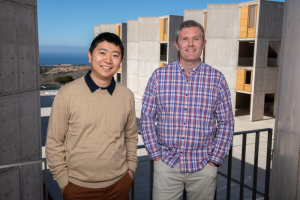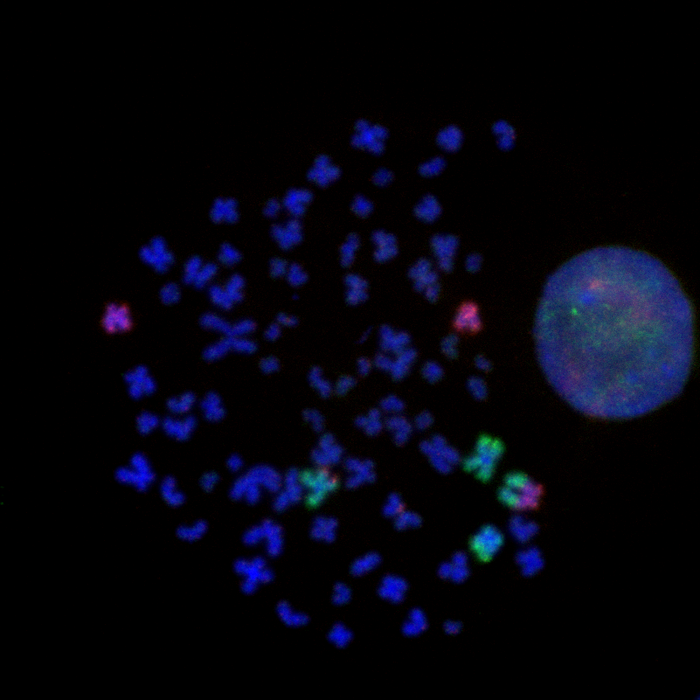Cancer can be caused by genetic mutations, but the impact of specific types, such as structural variants that break and rejoin DNA, can vary widely. Researchers headed by a team at the Salk Institute have now zeroed in on specific mechanisms that activate oncogenes, which are altered genes that can cause normal cells to become cancer cells. The team’s new study has shown that the activity of those mutations depends on the distance between a particular gene and the sequences that regulate the gene, as well as on the level of activity of the regulatory sequences involved. The findings could help scientists predict and interpret which genetic mutations found in cancer genomes are causing the disease.
“If we can better understand why a person has cancer, and what particular genetic mutations are driving it, we can better assess risk and pursue new treatments,” said Salk physician-scientist Jesse Dixon, MD, PhD, an assistant professor in the gene expression laboratory. Dixon is senior author of the team’s paper, which is published in Nature, and titled, “Structural variants drive context-dependent oncogene activation in cancer.”
The precise 3D structure of the genome is critical for the regulation of genes by sequences known as distal enhancers, the authors explained. “Structural variants (SVs) that alter 3D genome organization can lead to enhancer–promoter rewiring and human disease, particularly in the context of cancer.” Recently, they further noted, both germline and somatic mutations that alter 3D genome structure have been discovered that rewire enhancer–promoter communication and alter gene expression in human disease. This is a process known as “enhancer hijacking.”
However, most genetic mutations have no impact on a cancer, and the molecular incidents that lead to oncogene activation are relatively rare. “… only a small minority of SVs are associated with altered gene expression, it remains unclear why certain SVs lead to changes in distal gene expression and others do not,” the team continued. “Despite our increasing appreciation of the role of SVs in leading to enhancer hijacking, more recent studies have shown that, in fact, few SVs actually lead to changes in nearby expression of genes.” And as they pointed out, “as with many ‘noncoding’ somatic mutations, evaluating the functional consequences of any specific event is challenging.”
Dixon’s lab studies how genomes are organized in 3D space and seeks to identify factors that might distinguish where and when these events occur and impact on cancer. “A gene is like a light and what regulates it are like the light switches,” said Dixon. “We are seeing that, because of structural variants in cancer genomes, there are a lot of switches that can potentially turn ‘on’ a particular gene.”

They found that some of the created variants had major impacts on the expression of nearby genes, and could ultimately cause cancer. However, most had essentially no impact. Some genes appeared to go haywire when they were brought into environments with novel regulatory sequences, and others were not affected at all. The type of sequence that was introduced appeared to have a huge impact on whether or not the cell became cancerous.
“By using CRISPR–Cas9 genome engineering to generate de novo SVs, we show that oncogene activity can be predicted by using “activity-by-contact” [ABC] models that consider partner region chromatin contacts and enhancer activity,” they noted. “In our ABC models, the expression of a gene is related to the sum of the enhancers it contacts weighted by the strength of those contacts … Critically, the expression of only a subset of genes is sensitive to these engineered rearrangements, and we observe that only a minority of genes in the genome show evidence of responsiveness to changes in their local enhancer landscape.”
The results indicate that genes may “sample” distal enhancers through long-range chromatin contacts and integrate these interactions into final gene expression levels, the team pointed out. However, they noted, these ABC models are only predictive of specific subsets of genes in the genome, which suggests that different classes of genes engage in distinct modes of regulation by distal regulatory elements.
“Our next move is to test whether there are other factors in the genome that contribute to the activation of oncogenes,” said Zhichao Xu, PhD, a postdoctoral fellow at Salk and the paper’s co-first author. “We are also excited about a new CRISPR genome editing technology we are developing to make this type of genome engineering work much more efficient.” In their paper, the authors concluded, “These experiments indicate that the likelihood of activation of an oncogene is associated with the ‘enhancer load’ and 3D genome conformation of the partner region and can be predicted by using models that integrate these features, such as activity-by-contact (ABC) models … These results indicate that SVs that alter 3D genome organization are widespread in cancer genomes and begin to illustrate predictive rules for the consequences of SVs on oncogene activation.”


